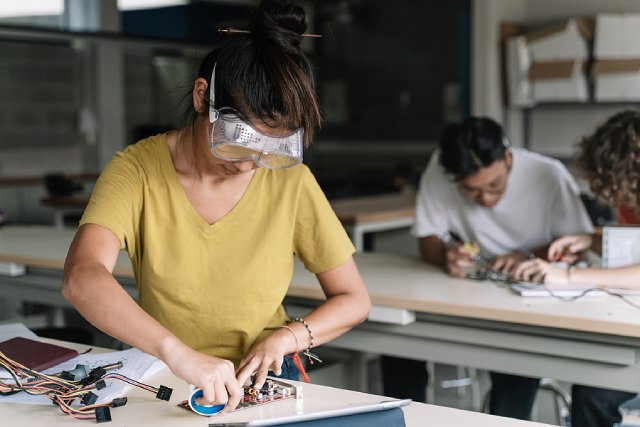Pure vs. Combined: What Makes Them Different From Each Other?
After the examinations are taken, and results are collected, students always ask at the end of Secondary 2: Should I take Combined Science or Pure Biology/Chemistry/Physics?
This is a legitimate question because the two have many critical differences. Examples include content length, syllabus, and even how they can decide the course you can take after O Level.
Should your child be on the fence between the two, it’s an excellent idea to educate and get them to learn as much information on the matter as possible before making their choice. This article will highlight the differences between pure and combined sciences and our recommendations to help your child make their choice.
Difference 1: Number of assessments & grading system
When it comes to the science syllabus in secondary schools in Singapore, they have a hands-on and practical examination.
For Triple or Double Pure Sciences, students will take three or two distinct assessments during the curriculum. This is called school-based Science Practical Assessment (SPA). In contrast, Combined Science students only take one practical assessment, Paper 5, under O Level.
Moreover, Pure Science students are evaluated based on the experimental methods and answer scripts. On the other hand, Combined Science students receive their grades from the answer scripts only.
Difference 2: The final academic results
One of the main differences between Pure Sciences and Combined Sciences is the number of O Level Exams you must take.
Let’s take an example of Pure Physics and Pure Chemistry and Combined Science (Physics/Chemistry). In the case of Pure Science, you will have to sit for two O Level Exams (Pure Physics and Pure Chemistry). You will also have two results recorded in your result slip. For instance, if you got an A1 for Chemistry but a C5 for Physics, it will reflect two different results.
For Combined Science, you’ll be sitting for just one paper. As the name implies, the grades in Combined Science are combined. In this case, if you get an A1 in Chemistry but a C5 in Physics, you may get an average grade of B3.
Difference 3: The question allocation & weightage
Another distinct characteristic is when it comes to theory paper for Pure Sciences, they have a higher percentage of questions that involve Handling Information and Solving Problems (HISP) and less recall type questions in comparison to Combined Science.
The assessment objectives’ weightage are also different between Pure and Combined Sciences, as listed below:
Side note: Knowledge with Understanding is where students are needed to recall and explain the factual knowledge that the subject content defines.
Handling Information and Solving Problems is where students have to utilise syllabus principles and concepts to apply them in a logical, reasoned, or deductive way towards a unique situation in the paper.
In the case of pure sciences, the exams require a more in-depth understanding towards the topics, and how the concepts can be applied in real life when answering the questions.
Difference 4: The exam format
The exam format for Pure Sciences and Combined Sciences are as follows:
What should your child choose?
Taking Pure Science can benefit your child if they are looking to opt for GCE ‘A’ Level (Science stream) or any Science-related course for local Polytechnics in Singapore after their O Levels. If your child cannot cope with Pure Science, MOE will offer a chance to convert to Combined Sciences before you enter Secondary 4.
When it comes to covering the content, Combined Sciences is around 75% of Pure Sciences.
Think of the difficulty between Combined and Pure Sciences this way: Combined Science is considered Level 1 in difficulty, which covers more on the fundamental knowledge and concepts. Pure Sciences are considered Level 2. The Level 3 difficulty would be the H2 Sciences in JC.
Putting it simply, should students enter JC and take up H2 Sciences, those from Combined Science would need to put in more effort to catch up to those who took Pure Sciences.
Hence, comes the next question: should your child take Double Science or Triple Science as part of their subject combination?
Generally, students are only advised to go for Triple Science if they obtained an excellent grade (around 85 and above) for their Lower Secondary Sciences. Otherwise, it’s better to take Double Science.
It’s a myth that Combined Sciences are only for those lower ability learners. They are simply offered to those who may not excel in science, but these students can do well in other subjects, such as Humanities, which have nothing to do with science. Note that those taking Combined Science can also excel in their O Levels.
Conclusion
When it comes to something like subject combinations, it’s best to think about several factors before making a choice. If your child is in Secondary 3 taking Pure Sciences, whether they want to switch to Combined Sciences is not solely dependent on their results. Instead, they should only change if they are not confident.
After all, some students failed their Pure Science in Secondary 3 but scored well in their O Levels. Hence, doing well for Pure Science is not impossible.
Should your child need extra help in their Pure or Combined Science, Glenn Lee Learning Centre is here to lend a helping hand, with our O level Pure Chemistry tuition and O level Pure Physics tuition.
Our private tutors for O Levels in Singapore can develop personalised lesson plans and teaching methods, allowing your child to learn at a pace comfortable to them.
With our signature ACE Methodology, your child is sure to show improvements under our tutelage. For more details, contact us or visit our centre.



